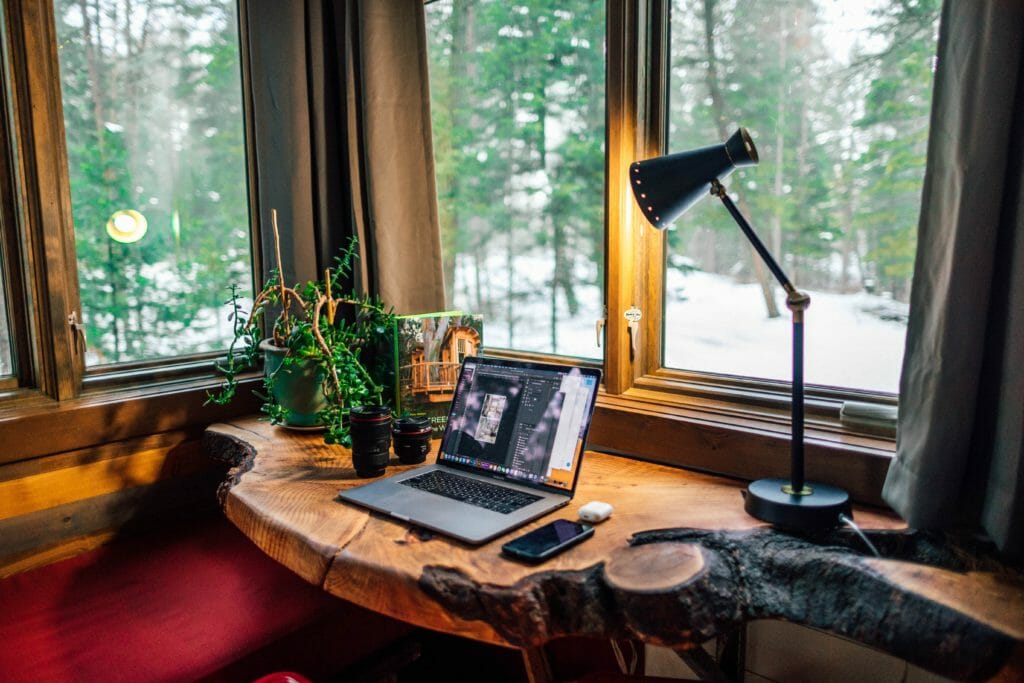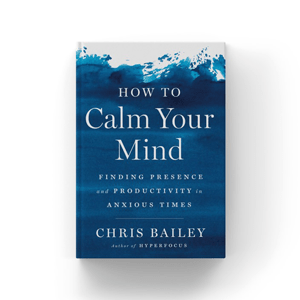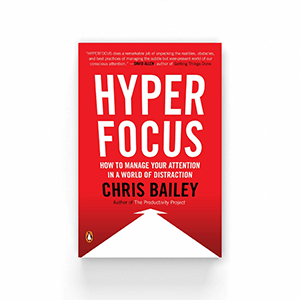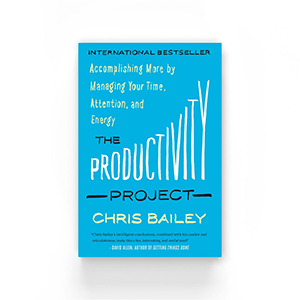Estimated Reading Time:7 minutes, 11s. (But it’s skimmable.)
Podcast Length27 minutes, 45s (link to play podcast at bottom of post).

These days, it can be tough to strike a balance between staying informed and staying focused.
Compared to fighting a global pandemic, work doesn’t feel that important. And compared to a pandemic, it probably isn’t. But this doesn’t change the fact that many of us are working from home right now—and that we still have to get things done while focusing on work and keeping up with a steady stream of news updates.
This isn’t “normal” working from home by any means. As you settle into a new routine, though, I’ve included a few of my favorite tips to work from home during difficult times below. These are strategies that have worked for me, as I try to find a balance right now. I think they’ll work for you, too.
—
Give yourself time to settle into important tasks, and be patient with yourself. A busy mind makes it difficult to focus. Give yourself a few more minutes than usual to settle into important tasks that require a higher degree of concentration. You’ll probably need that time, so your mind can settle down a bit. Don’t be too hard on yourself during this adjustment—pretty much everyone is experiencing this right now.
Take the time you would usually spend commuting and use it for something slow, or to savor something you enjoy. With the time you’d otherwise spend commuting, take a walk, cook a meal, or even do a yoga video on YouTube (here’s my favorite YouTube yoga channel). During stressful times, we tend to fill the white space on our calendar with distraction, so we can get our mind off of what’s stressing us. Try not to fill your extra time each day with anxiety scrolling through twitter, or repeatedly checking the news. This will give you the time you need to process each day’s events.
Totally power down your phone. Our phones are the most distracting device we own. As Seth Godin has written, “When you bought your first smartphone, did you know you would spend more than 1,000 hours a year looking at it? Months later, can you remember how you spent those hours?” Our phone provides us with validation and feedback—which our work often doesn’t. Especially during a difficult time, this makes our phone more distracting than usual. To not be tempted by it, try powering your phone down completely as you work.
If you’re getting less sunlight these days, consider buying a happy light, or taking a vitamin D supplement. In countries that have instituted lockdowns, people are unable to leave their homes, including for walks. If this is the situation you’re in, and you’re getting less sun exposure than usual, I’d recommend supplementing your diet with vitamin D, or picking up a ”happy light”—especially if you find that your mood and energy dip in the wintertime. Here’s my happy light of choice, which Wirecutter recommends.
Do focused work in the morning, before connecting to the news. One study that exposed participants to just three minutes of negative news in the morning found that participants were 27% less likely to rate themselves as happy at the end of the day. The information you consume each day matters. This is even true when it comes to when you consume information. To prevent the news of the day from dampening your mood for the rest of the day, consider reconnecting with the news of the day after you finish up your most important tasks in the morning.
Schedule news and distraction time. On top of staying away from the news first thing in the morning (if you can), consider scheduling time to catch up. This allows you to tend to distractions intentionally, rather than checking in with news websites when you feel stressed out. This small change also makes you feel more in control of your day.
If you feel anxious, work on tasks that don’t require deep concentration or thinking. Right now is an anxious time for pretty much everyone. Our feelings of anxiety usually aren’t consistent throughout the day, though; they ebb and flow. When you’re feeling especially anxious, consider working on tasks that don’t require deep concentration or thinking—and use these easy tasks to warm up to more challenging ones later on. As the day progresses, be sure to match what you’re working on with how you’re feeling.
If you have kids at home, look after them in split shifts if your partner is at home too. My friend Laura Vanderkam has a great write-up for how her and her husband are taking care of their five kids while they’re both working from home—including taking care of them in split shifts, while trading the occasional hour or two with one another throughout the day. If you’re home alone with kids, also use morning and nighttime hours—while your kids are asleep—to your advantage. Provide your kids with especially rewarding distractions (like screen time) for when you’re on conference calls or in important meetings.
Create an “invisibility mode” with everyone else in the house. If you’re self-isolating with a roommate, partner, or your family, it’s important to have some outward signal that you’re working, so they don’t interrupt you unnecessarily. I have a home office, so I just close the office door. My wife, who only sporadically worked from home before today, either wears headphones or sticks a post-it note on the back of computer that says that she’s focused.
Communicate more richly with your team. The presence of other people is motivating. If you’re going from being face-to-face with colleagues every day to working from home, you’re probably going to feel like you have a bit less energy throughout the day. For this reason, make a deliberate effort to communicate in a richer way with those on your team. If you’d usually send someone a message over Slack, pick up the phone instead. If you’d usually chat with someone over the phone, suggest meeting on Skype or Zoom.
Don’t keep chips in the house. If there are chips—or other unhealthy snacks—in the house while I’m working from home, I’ll devour them all in a day or two. If you’re spending most of your time at home, it’s important to not have unhealthy snacks or other unsavory distractions out of the house. (My wife and I have a running joke that “corona calories” don’t count, but I have the sneaking suspicion that they do.) Unhealthy snacks can also sap your energy later on, making you less energized and productive.
Give yourself a to-do list every day. Writing a to-do list each morning is a great, simple way to introduce more structure into your day. Don’t have too many items on your list, and deploy the Rule of 3 (my favorite productivity ritual, in which you set three intentions each day) as well.
Integrate exercise into every single day. If you’re forced to self-isolate, getting daily exercise is not a suggestion—it’s pretty much a requirement. Exercise supports your mental health by balancing your brain chemistry, gives you energy, and is one of the best stress-relievers in existence. If you’re working from home, you’ll be getting less physical activity each day as a result. You need to compensate for this by exercising more at home. If you can, order a kettlebell or resistance bands online. Blow the dust off your old fitness gear in the basement, and get your heart rate up. Find a local fitness studio that’s now posting classes online or take advantage of the many online workout channels. Take a half-hour walk outside every day, if you can. However possible, get around 30 minutes of daily physical activity.
Have rituals that you depend upon. The world shutting down has a way of upending pretty much all of our daily rituals. Because of this, you’ll need to introduce new daily rituals into your own life, to introduce predictability, consistency, and a feeling of control into your workday. A few suggestions for doing this: have a daily time at which you start and finish up work; set a dinnertime each night with your family; and set up a dedicated workspace for yourself.
Pick your music choices deliberately. The best music for productivity has two characteristics: it’s both simple (so it doesn’t distract us) and familiar (so we don’t think much about it as we’re listening to it). Lately, I’ve been listening to a lot of lo-fi hip hop, and loving it—it has no words, so it’s super simple, and it’s pretty familiar (the songs seem to blend into one another). I’m also a big fan of listening to songs on Repeat One as I work. To use music to become more productive, listen to anything that’s both simple and familiar, or try going without any if that’s your preference.
Relegate one device to be your distractions device. This is a distracting time. If you have more than one computer—including an iPad—use the extra device as your distractions device. This way, you can use one device to check up on everything: the news, your social media feeds, and messages from friends. This also allows you focus more easily in front of your main computer, when it’s time to work.
Track your time. To track your time, keep a notepad on your desk as you work, and write down what you’re working on throughout the day in 15-minute blocks of time. There are also lots of apps that you can use to do this on your computer for screen-related work. This simple ritual introduces an extra layer of accountability into your days. When you’re mindful of what you’re working on throughout the day, you spend your time far more intelligently.
—
If you’re finding it challenging to focus and be productive right now, you’re certainly not alone. I’ve personally found the above strategies enormously helpful for getting more accomplished. I’m confident that you will, too.




